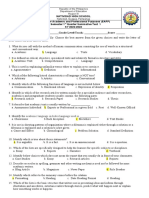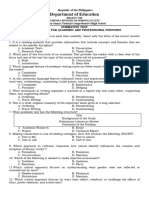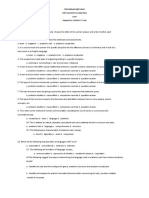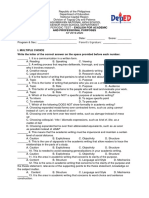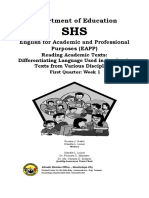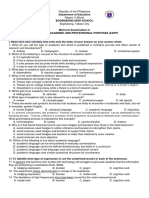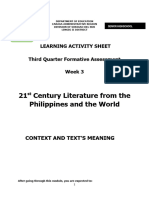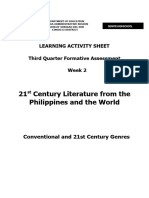0 ratings0% found this document useful (0 votes)
1 viewsEAPP Quarter 1
EAPP Quarter 1
Uploaded by
Solanum Lauro OrculloExam 1
Copyright:
© All Rights Reserved
Available Formats
Download as DOCX, PDF, TXT or read online from Scribd
EAPP Quarter 1
EAPP Quarter 1
Uploaded by
Solanum Lauro Orcullo0 ratings0% found this document useful (0 votes)
1 views4 pagesExam 1
Copyright
© © All Rights Reserved
Available Formats
DOCX, PDF, TXT or read online from Scribd
Share this document
Did you find this document useful?
Is this content inappropriate?
Exam 1
Copyright:
© All Rights Reserved
Available Formats
Download as DOCX, PDF, TXT or read online from Scribd
Download as docx, pdf, or txt
0 ratings0% found this document useful (0 votes)
1 views4 pagesEAPP Quarter 1
EAPP Quarter 1
Uploaded by
Solanum Lauro OrculloExam 1
Copyright:
© All Rights Reserved
Available Formats
Download as DOCX, PDF, TXT or read online from Scribd
Download as docx, pdf, or txt
You are on page 1of 4
Name: _____________________________________________ Score: ___________
Grade & Section: _________________________________ Date: _____________
1ST QUARTER
EXAMINATION
ENGLISH FOR ACADEMIC AND PROFESSIONAL PURPOSES
General Instruction. Read each statement properly. Encircle the letter that best corresponds to the statement. No Erasure
1. Which of the following is NOT true about the reaction paper?
a. The writer expresses ideas and opinions about what has been read or seen.
b. It may be informal, two pages long.
c. It has an introduction, body and conclusion.
d. It is summary of the article.
2. Which of the following should be included in the first part of the reaction paper?
a. Personal thoughts
b. Information about the author
c. Main problem
d. Sources
3. Which of the following are used to learn more about the structure of reaction paper?
a. Examples
b. Opinions
c. Reactions
d. Traditions
4. Which of the following is NOT a form of reaction paper?
a. Appeal
b. Protest
c. Reflection
d. Report
5. This refers to the attitude conveyed in a piece of writing.
a. Tone
b. Language
c. Citation
d. Complexity
6. An academic text requires higher order thinking skills to comprehend.
a. Tone
b. Language
c. Citation
d. Complexity
7. It is one of the features of academic texts that facts are given accurately.
a. Complex
b. Formal
c. Precise
d. Objective
8. It has fewer words that emphasize on the information you want to give and arguments you want to make.
a. Complex
b. Formal
c. Precise
d. Objective
9. It is necessary to make decisions about your stance on a particular subject.
P-3 Anibongan, Lingig, SDS 8312 Phils.
0953-0982-584
Anibongan Integrated School
500581@deped.gov.ph
a. Hedging
b. Responsible
c. Organize
d. Plan
10. It usually takes place after research and evaluation, according to specific purpose.
a. Hedging
b. Responsible
c. Organize
d. Plan
11. These are the purposes of reading an academic text, EXCEPT:
a. To locate main idea
b. To scan information
c. To connect old ideas to existing ones
d. To gain more pieces of information
12. These are the factors to consider in writing academic text, EXCEPT:
a. State critical questions and issues
b. Provide facts and evidence from credible sources.
c. Use precise and accurate jargon words.
d. Use cautious language.
13. Here are some of the definitions of social language, EXCEPT:
a. Can use phrases.
b. Can use variety of terms.
c. Can be repetitive.
d. Can use slang words.
14. Here are some of the definitions of academic language, EXCEPT:
a. Used in school, work conversations.
b. Used to write friends and family.
c. Uses sentences.
d. Used appropriate transitions.
15. It refers to the way authors organize information in text.
a. Academic text
b. Text Structures
c. Structure of text
d. Text of Academic
16. It provides explanations or reasons for phenomena.
a. Problem/Solution
b. Cause and effect
c. Compare and Contrast
d. Sequence
17. Discuss two events, ideas, or phenomena showing how they are different and how they are similar.
a. Problem/Solution
b. Cause and effect
c. Compare and Contrast
d. Sequence
18. It is how we take larger selections of text and reduce them to their bare essential.
a. Transitioning
b. Deleting
c. Summarizing
d. Remembering
19. SAAC is an acronym for __________.
P-3 Anibongan, Lingig, SDS 8312 Phils.
0953-0982-584
Anibongan Integrated School
500581@deped.gov.ph
a. State, Assign, Action, Complete
b. State, Action, Assign, Complete
c. State, Assist, Active, Complete
d. State, Active, Assist, Complete
20. It is the controlling idea that you will develop in your idea.
a. Summary
b. Thesis Statement
c. Abstract
d. Outline
21. The support for your argument/claim.
a. Gist
b. Argument/Claim
c. Evidence
d. Topic
22. This depends on the type of paper you are writing. If it is an argumentative paper, then this should express your
opinion.
a. Gist
b. Argument/Claim
c. Evidence
d. Topic
23. It is a design to follow when writing structure, a discourse, or a article.
a. Summary
b. Thesis Statement
c. Abstract
d. Outline
24. Here are the guidelines in writing an outline, EXCEPT:
a. Place the at the center below the outline.
b. Capitalize the first letter of each item.
c. Indent each new level of the outline.
d. Put a period after each numeral and letter.
25. This approach “seeks to understand a literary work by investigating the social, cultural and intellectual context”.
a. Gender Criticism
b. Historical Criticism
c. Formalist Criticism
d. Structuralism
26. It focused on how human behavior is determined by social, cultural and psychological context.
a. Gender Criticism
b. Historical Criticism
c. Formalist Criticism
d. Structuralism
27. It is to determine how such elements work together with the text’s content to shape its effects upon readers.
a. Gender Criticism
b. Historical Criticism
c. Formalist Criticism
d. Structuralism
28. Which critical approaches focuses on ways texts reflect, reinforce, or challenge the effects of class, power
relations, and social roles.
a. Reader-response
b. Feminism
c. Historicism
P-3 Anibongan, Lingig, SDS 8312 Phils.
0953-0982-584
Anibongan Integrated School
500581@deped.gov.ph
d. Marxist
29. Which critical approach focuses on understanding texts by viewing texts in the context of other texts?
a. Reader-response
b. Feminism
c. Historicism
d. Marxist
30. Which critical approach focuses on each reader’s personal reactions to a text?
a. Reader-response
b. Feminism
c. Historicism
d. Marxist
II. Enumeration
31-33 Text Structure
34-35 Techniques in Summarizing Academic Texts
36-38 Elements of Thesis Statement
39-41 Basic structure of an academic text
42-43 Transitions/Signal words of Cause and Effect
44-45 Transitions/Signal words of Chronological, Process, or Sequence
46-47 Transitions/Signal words of Definition or Description
48-50 Basic Rules of Techniques in Summarizing Academic Texts
P-3 Anibongan, Lingig, SDS 8312 Phils.
0953-0982-584
Anibongan Integrated School
500581@deped.gov.ph
You might also like
- Pre Test Eapp 2022 23Document3 pagesPre Test Eapp 2022 23Kianna Marie Vitug100% (2)
- Modified True or False. Write EAPP If The Statement Is True. If The Statement Is False, Underline TheDocument2 pagesModified True or False. Write EAPP If The Statement Is True. If The Statement Is False, Underline TheErika PhoebeNo ratings yet
- Law No. 6 of 2019Document31 pagesLaw No. 6 of 2019binoyjmatNo ratings yet
- EAPP - Second Quarter ExamDocument5 pagesEAPP - Second Quarter ExamRomnickCelestinoNo ratings yet
- Eapp 1STQ ExamDocument5 pagesEapp 1STQ Exampaul.porrasNo ratings yet
- Eapp Summative TestDocument4 pagesEapp Summative Testjuainy aggabaoNo ratings yet
- EAPPDocument4 pagesEAPPFrenalyn Cerilla SantiagoNo ratings yet
- I. Directions: Choose The Letter of The Best AnswerDocument4 pagesI. Directions: Choose The Letter of The Best AnswerJohn MontenegroNo ratings yet
- EAPP MT ExamDocument6 pagesEAPP MT Examkimbeerlyn doromasNo ratings yet
- Summative EappDocument7 pagesSummative Eappjoaonnarose1196No ratings yet
- Pre-Test (ENG1B)Document3 pagesPre-Test (ENG1B)Resweetcel BongabongNo ratings yet
- EAPP Dianostic Test 2023-2024Document4 pagesEAPP Dianostic Test 2023-2024Inapulangan HomonhonNo ratings yet
- Mid Term Exam - Eapp 11Document6 pagesMid Term Exam - Eapp 11Nelissa Pearl ColomaNo ratings yet
- EAPP 1st Periodical TestDocument5 pagesEAPP 1st Periodical TestMeschelle SeloveresNo ratings yet
- Midterm in English For Academic and Professional PurposesDocument4 pagesMidterm in English For Academic and Professional PurposesMelanie CortezNo ratings yet
- National Achievement TestReviewer Answer KeyDocument3 pagesNational Achievement TestReviewer Answer Keyje-ann montejoNo ratings yet
- True or False. Write EAPP If The Statement Is True, and NOT If It Is FalseDocument2 pagesTrue or False. Write EAPP If The Statement Is True, and NOT If It Is FalseErika PhoebeNo ratings yet
- EAPP 1st Q-ExamDocument6 pagesEAPP 1st Q-ExamRomeo Espinosa Carmona JrNo ratings yet
- 1st Quarter Exam-EAPP-WPS OfficeDocument7 pages1st Quarter Exam-EAPP-WPS OfficeSharifa Gani SarmientoNo ratings yet
- EAPP Midterm (rEVIEWERDocument3 pagesEAPP Midterm (rEVIEWERCHERRY ANN OLAJAYNo ratings yet
- EAPP MT ExamDocument4 pagesEAPP MT Examkimbeerlyn doromasNo ratings yet
- 12 TVL IctDocument5 pages12 TVL IctNj SarioNo ratings yet
- 1st Quarter-EAPPDocument5 pages1st Quarter-EAPPSarah Mae MacarandanNo ratings yet
- First Pta CadDocument3 pagesFirst Pta CadMonalisa Silvio IntegroNo ratings yet
- Summative Test in EappDocument2 pagesSummative Test in EappAbbegailPearl AguirreNo ratings yet
- Schools Division Office Urdaneta City Urdaneta City National High SchoolDocument5 pagesSchools Division Office Urdaneta City Urdaneta City National High SchoolJemimah Rabago PaaNo ratings yet
- eapp test questions summativeDocument4 pageseapp test questions summativeAnn Corpuz-MacaraegNo ratings yet
- Victorias National High School: I. Directions: Read The Questions Carefully and Choose The Letter of The Correct AnswerDocument2 pagesVictorias National High School: I. Directions: Read The Questions Carefully and Choose The Letter of The Correct AnswerGladys CastroNo ratings yet
- InquiriesDocument4 pagesInquiriesAlejandro Jr. RicardoNo ratings yet
- S2Q3 Periodic Test EappDocument6 pagesS2Q3 Periodic Test EappJVNo ratings yet
- EAPP Exam1Document2 pagesEAPP Exam1vanteacher23No ratings yet
- EAPP 1st QuarterDocument5 pagesEAPP 1st QuarterJohn Paul FornillosNo ratings yet
- 1st Quarter Exam (2022-2023)Document9 pages1st Quarter Exam (2022-2023)Larry ErbiteNo ratings yet
- Eapp Final ExamDocument5 pagesEapp Final ExamRoxette MarieNo ratings yet
- English For Academic and Professional Purposes-TVL HE and ICT 11Document3 pagesEnglish For Academic and Professional Purposes-TVL HE and ICT 11irish03niceNo ratings yet
- Sdo Navotas Shs Eeap Firstsem Fv-1Document100 pagesSdo Navotas Shs Eeap Firstsem Fv-1seungkwan booNo ratings yet
- EAPP SummativeDocument2 pagesEAPP SummativeRoland John MarzanNo ratings yet
- 1st Quarter Exam in EAPPDocument3 pages1st Quarter Exam in EAPPLiza Valerio AquinoNo ratings yet
- EAPPDocument6 pagesEAPPDaypuyart Condez BernardNo ratings yet
- Second Periodical Test in Eapp 2022 2023Document3 pagesSecond Periodical Test in Eapp 2022 2023dbaldedomar.padriquezNo ratings yet
- I. Multiple Choice. Choose The Letter of The Best AnswerDocument5 pagesI. Multiple Choice. Choose The Letter of The Best AnswerRainee Anne DeveraNo ratings yet
- BC AnswersDocument12 pagesBC AnswersJe RomeNo ratings yet
- Summative Test (Eapp) )Document3 pagesSummative Test (Eapp) )Mark Kevin VillarealNo ratings yet
- First Periodical Test Research IiDocument3 pagesFirst Periodical Test Research IiDionesio OcampoNo ratings yet
- EAPPDocument3 pagesEAPPk65c6dxpdtNo ratings yet
- Department of Education: English For Academic and Professional Purposes (EAPP)Document10 pagesDepartment of Education: English For Academic and Professional Purposes (EAPP)marvinNo ratings yet
- Department of Education: English For Academic and Professional Purposes (EAPP)Document10 pagesDepartment of Education: English For Academic and Professional Purposes (EAPP)marvinNo ratings yet
- Eapp Answer Key: Education (Daraga Community College)Document5 pagesEapp Answer Key: Education (Daraga Community College)Rony Caratao BargasNo ratings yet
- Eapp Answer KeyDocument4 pagesEapp Answer KeyRhea Tecson-Saldivar CastilloNo ratings yet
- TQ (Reading and Writing)Document2 pagesTQ (Reading and Writing)Mai Mai ResmaNo ratings yet
- Pre TestDocument3 pagesPre TestResweetcel BongabongNo ratings yet
- Department of Education Division of Cebu ProvinceDocument6 pagesDepartment of Education Division of Cebu ProvinceNelsie FernanNo ratings yet
- Eapp-Posttest 1ST Sem 2021-2022 2Document2 pagesEapp-Posttest 1ST Sem 2021-2022 2lomapo100% (1)
- Diagnostic Test in EAPP 11Document6 pagesDiagnostic Test in EAPP 11Ilham Jhann AcramanNo ratings yet
- First Periodical Test Research IIDocument3 pagesFirst Periodical Test Research IIBuzz manzhjanaNo ratings yet
- Midterm Exam 2 1Document4 pagesMidterm Exam 2 1France Bitare100% (1)
- Pretest in EAPP Q1Document4 pagesPretest in EAPP Q1yozora00803No ratings yet
- Third Quarter Summative Assessment Week 7 & 8Document2 pagesThird Quarter Summative Assessment Week 7 & 8Melvin Jake ManaogNo ratings yet
- Central Bukidnon InstituteDocument6 pagesCentral Bukidnon Institutesmurf accountNo ratings yet
- Eapp Diagnostic TestDocument4 pagesEapp Diagnostic TestEMzFajardoNo ratings yet
- Common Core Snapshot: Administrator's Guide to the Common CoreFrom EverandCommon Core Snapshot: Administrator's Guide to the Common CoreNo ratings yet
- 1st Quarter TOS in UCSPDocument1 page1st Quarter TOS in UCSPSolanum Lauro OrculloNo ratings yet
- Entrep Quarter 1Document6 pagesEntrep Quarter 1Solanum Lauro OrculloNo ratings yet
- 1st Quarter TOS in EAPPDocument1 page1st Quarter TOS in EAPPSolanum Lauro OrculloNo ratings yet
- Week 3Document7 pagesWeek 3Solanum Lauro OrculloNo ratings yet
- 21ST Century - Week 2Document9 pages21ST Century - Week 2Solanum Lauro OrculloNo ratings yet
- Week 5Document7 pagesWeek 5Solanum Lauro OrculloNo ratings yet
- Lesson PlanDocument7 pagesLesson PlanRONNIE JR. DELA CRUZ BUSALPANo ratings yet
- Drawing Gardu New Main Substation (MSS) 2Document17 pagesDrawing Gardu New Main Substation (MSS) 2karangraharjajayaperkasaNo ratings yet
- Hospital Pharmacy Activity 6, 7Document9 pagesHospital Pharmacy Activity 6, 7Alyssa Marie Petonio BialaNo ratings yet
- Rewards Are Better Than PunishmentDocument5 pagesRewards Are Better Than PunishmentSzékely TimeaNo ratings yet
- The Amazing Space AdventureDocument10 pagesThe Amazing Space AdventureLe KordyNo ratings yet
- AIChE Journal - 2021 - Balakotaiah - Modular Reactors With Electrical Resistance Heating For Hydrocarbon Cracking and OtherDocument10 pagesAIChE Journal - 2021 - Balakotaiah - Modular Reactors With Electrical Resistance Heating For Hydrocarbon Cracking and Othersangram.ryNo ratings yet
- BBC Three Channel 4 Target AudienceDocument13 pagesBBC Three Channel 4 Target Audienceapi-248652868No ratings yet
- Allen Part Pedia CaseDocument3 pagesAllen Part Pedia CasePaul Michael Baguhin0% (1)
- News From The Spirit World - A Checklist of American Spiritualist Periodicals 1847-1900Document65 pagesNews From The Spirit World - A Checklist of American Spiritualist Periodicals 1847-1900Khoa LeNo ratings yet
- NewDocument2 pagesNewfihamNo ratings yet
- HMS CockerelDocument7 pagesHMS CockerelbillcrewsNo ratings yet
- Late Medieval French: Army Values Dice PointsDocument1 pageLate Medieval French: Army Values Dice PointsNosmo KingNo ratings yet
- English To Tagalog - Google SearchDocument1 pageEnglish To Tagalog - Google SearchAiman PangitNo ratings yet
- Unit 4 Food and MeasurementsDocument12 pagesUnit 4 Food and MeasurementsJsy DayanaNo ratings yet
- Bachan Singh and Ors Vs State of Punjab and Ors s820276COM58757Document70 pagesBachan Singh and Ors Vs State of Punjab and Ors s820276COM58757praakhar.devNo ratings yet
- Percentage 1 (Cat - 22 Weekdays)Document20 pagesPercentage 1 (Cat - 22 Weekdays)hktester102No ratings yet
- Lumanog Vs PeopleDocument65 pagesLumanog Vs Peoplejon_cpaNo ratings yet
- Criminology Project 2018Document21 pagesCriminology Project 2018Ahat SharmaNo ratings yet
- Speaking SkillsDocument16 pagesSpeaking SkillsOsman AhmedNo ratings yet
- Fate and Luck & Communication Skills.Document55 pagesFate and Luck & Communication Skills.S Sohaib HGNo ratings yet
- Addressing Diversity Through Special Education and InclusionDocument3 pagesAddressing Diversity Through Special Education and InclusionMonica MasanaNo ratings yet
- BEHRINGER - QX2442USB P0AL3 - Product Information DocumentDocument9 pagesBEHRINGER - QX2442USB P0AL3 - Product Information DocumentGabriel AsensNo ratings yet
- Pre Policia AritmeticaDocument16 pagesPre Policia AritmeticaGilberto MosqueraNo ratings yet
- Provisional Acceptance Test: ChecklistDocument8 pagesProvisional Acceptance Test: ChecklistOrcino RonelNo ratings yet
- Simulado 1 para ImpressãoDocument6 pagesSimulado 1 para ImpressãoFelipheDisintegratorNo ratings yet
- NLR77 TILT W Alum VanDocument1 pageNLR77 TILT W Alum Vanİåň ŞåböçöNo ratings yet
- BaaaaanuDocument7 pagesBaaaaanuchinni madhuNo ratings yet
- Incident Report (Undercharged Fleet Card Transaction)Document12 pagesIncident Report (Undercharged Fleet Card Transaction)Byron TorioNo ratings yet
- Perspectives On Innovations in Oral Health Care: R. Gary RozierDocument7 pagesPerspectives On Innovations in Oral Health Care: R. Gary Rozierfaradillah usmanNo ratings yet





